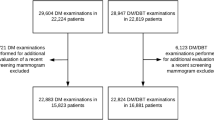Abstract
Background
The Verona population-based breast cancer (BC) screening program provides biennial mammography to women aged 50–69 years. Based on emerging evidence of enhanced detection, the program transitioned to digital breast tomosynthesis (DBT) screening.
Methods
This is a prospective pilot evaluation of DBT with synthesised 2D mammography screening implemented during April 2015–March 2017; the rate and characteristics of cancers detected at DBT screening were compared with those detected at the preceding digital mammography (DM) screening round (April 2013–March 2015) in the same screening program. Distribution of imaging and tumour characteristics were compared.
Results
Amongst 34,071 women screened in the Verona DBT pilot, 315 BCs were detected; 153 BCs were detected amongst 29,360 women in the DM screening round. Estimated CDRs were 9.2/1000 (95% CI 8.3–10.3) DBT screens versus 5.2/1000 (95% CI 4.4–6.1) DM screens, P < 0.001. Statistically significant differences were found in the distribution of whether recall by one/both screen readers (more BCs recalled by both readers at DBT than DM); whether detected on one/two views (higher proportion detected on only one view at DBT than DM); type of radiological lesions; tumour stage, pT and histological categories (lower proportion of DCIS/pTis, higher proportions of pT1a and pT1b, and higher proportion of invasive cancers of special types, at DBT than DM); and tumour grade (higher proportion of grade I at DBT than DM). There were no differences in distributions of nodal and hormone receptor (ER/PR) status.
Conclusions
Our findings provide early insights into the extent that transitioning to DBT screening may modify the characteristics of screen-detected breast cancer to inform discussion regarding pros and cons of DBT screening; although our data provide some reassurance that DBT does not increase the proportion of screen-detected DCIS, they highlight mixed findings on comparative tumour characteristics, suggesting a potential for enhancing screening benefit and possibly also over-diagnosis from DBT screening.
Similar content being viewed by others
References
Ciatto S, Houssami N, Bernardi D, Caumo F, Pellegrini M, Brunelli S et al (2013) Integration of 3D digital mammography with tomosynthesis for population breast-cancer screening (STORM): a prospective comparison study. Lancet Oncol 6(14):583–589
Skaane P, Bandos AI, Gullien R, Eben EB, Ekseth U, Haakenaasen U et al (2013) Prospective trial comparing full-field digital mammography (FFDM) versus combined FFDM and tomosynthesis in a population-based screening programme using independent double reading with arbitration. Eur Radiol 23(8):2061–2071
Houssami N, Macaskill P, Bernardi D, Caumo F, Pellegrini M, Brunelli S et al (2014) Breast screening using 2D-mammography or integrating digital breast tomosynthesis (3D-mammography) for single-reading or double-reading—evidence to guide future screening strategies. Eur J Cancer 50(10):1799–1807
Lång K, Andersson I, Rosso A, Tingberg A, Timberg P, Zackrisson S (2016) Performance of one-view breast tomosynthesis as a stand-alone breast cancer screening modality: results from the Malmo Breast Tomosynthesis Screening Trial, a population-based study. Eur Radiol 26(1):184–190
Bernardi D, Macaskill P, Pellegrini M, Valentini M, Fanto C, Ostillio L et al (2016) Breast cancer screening with tomosynthesis (3D mammography) with acquired or synthetic 2D mammography compared with 2D mammography alone (STORM-2): a population-based prospective study. Lancet Oncol 17(8):1105–1113
Friedewald SM, Rafferty EA, Rose SL, Durand MA, Plecha DM, Greenberg JS et al (2014) Breast cancer screening using tomosynthesis in combination with digital mammography. JAMA 311(24):2499–2507
McCarthy AM, Kontos D, Synnestvedt M, Tan KS, Heitjan DF, Schnall M et al (2014) Screening outcomes following implementation of digital breast tomosynthesis in a general-population screening program. J Natl Cancer Inst. https://doi.org/10.1093/jnci/dju316
Conant EF, Beaber EF, Sprague BL, Herschorn SD, Weaver DL, Onega T et al (2016) Breast cancer screening using tomosynthesis in combination with digital mammography compared to digital mammography alone: a cohort study within the PROSPR consortium. Breast Cancer Res Treat 156(1):109–116
Zuckerman SP, Conant EF, Keller BM, Maidment AD, Barufaldi B, Weinstein SP et al (2016) Implementation of synthesized two-dimensional mammography in a population-based digital breast tomosynthesis screening program. Radiology 281(3):730–736
Caumo F, Zorzi M, Brunelli S, Romanucci G, Rella R, Cugola L et al (2017) Digital breast tomosynthesis with synthesized two-dimensional images versus full-field digital mammography for population screening: outcomes from the Verona screening program. Radiology 13:170745
StatsDirect Ltd. (2016) StatsDirect statistical software (v3.0.167). Greater Manchester: StatsDirect Ltd.
StataCorp (2017) STATA statistical software: release 15. College Station: StataCorp LLC
Yun SJ, Ryu CW, Rhee SJ, Ryu JK, Oh JY (2017) Benefit of adding digital breast tomosynthesis to digital mammography for breast cancer screening focused on cancer characteristics: a meta-analysis. Breast Cancer Res Treat 164(3):557–569
Bernardi D, Caumo F, Macaskill P, Ciatto S, Pellegrini M, Brunelli S et al (2014) Effect of integrating 3D-mammography (digital breast tomosynthesis) with 2D-mammography on radiologists’ true-positive and false-positive detection in a population breast screening trial. Eur J Cancer 50(7):1232–1238
Houssami N, Lång K, Bernardi D, Tagliafico A, Zackrisson S, Skaane P (2016) Digital breast tomosynthesis (3D-mammography) screening: a pictorial review of screen-detected cancers and false recalls attributed to tomosynthesis in prospective screening trials. Breast 26:119–134
Tagliafico A, Mariscotti G, Durando M, Stevanin C, Tagliafico G, Martino L et al (2015) Characterisation of microcalcification clusters on 2D digital mammography (FFDM) and digital breast tomosynthesis (DBT): does DBT underestimate microcalcification clusters? Results of a multicentre study. Eur Radiol 25(1):9–14
Acknowledgements
N. Houssami receives research support through a National Breast Cancer Foundation (NBCF, Australia) Breast Cancer Research Leadership Fellowship.
Author information
Authors and Affiliations
Corresponding author
Ethics declarations
Conflict of interest
The authors declare that they have no conflict of interest.
Rights and permissions
About this article
Cite this article
Caumo, F., Romanucci, G., Hunter, K. et al. Comparison of breast cancers detected in the Verona screening program following transition to digital breast tomosynthesis screening with cancers detected at digital mammography screening. Breast Cancer Res Treat 170, 391–397 (2018). https://doi.org/10.1007/s10549-018-4756-4
Received:
Accepted:
Published:
Issue Date:
DOI: https://doi.org/10.1007/s10549-018-4756-4




